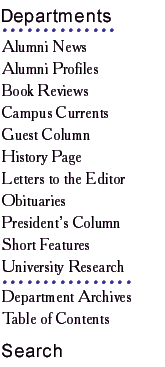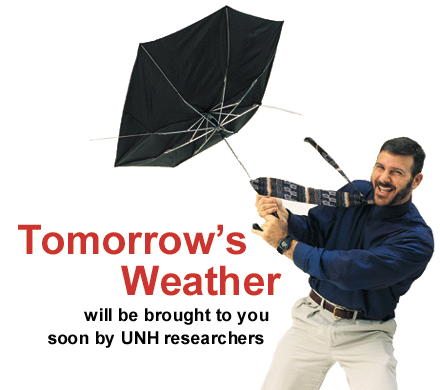

|
 Cover photo by Gary Samson 
|

By David Brooks See also: "There is a sumptuous variety about the New England weather that compels the stranger's admiration--and regret. The weather is always doing something there; always attending strictly to business; always getting up new designs and trying them on people to see how they will go. But it gets through more business in Spring than in any other season. In the Spring I have counted 136 different kinds of weather inside of 24 hours." --Mark Twain "There is an element of truth to that, but it's perhaps more spatial than temporal: If you don't like the weather, drive 100 yards and it will change," says Barry Keim, a UNH geography associate professor who also serves as New Hampshire's state climatologist. "The state's topography is so varied, you get much different weather from one spot to another. . . . There's many an afternoon when it's toasty warm in Durham, but if you drive to the seacoast, there's a sea breeze and it's 15 to 20 degrees colder. And at Mount Washington, of course, it's one climate at the bottom, but when you get to the top, it's another." Still, there's something to be said for the wait-five-minutes point of view, according to UNH research scientist Lynn Rosentrater. "I've really come to believe that little adage," she says. "The influences on New England's climate come from all directions: Air masses that move through can come from the Canadian plateau one day, from the Atlantic Ocean the next day, and up from the south the day after that. I can imagine that forecasting here in New England would be much more difficult than forecasting in, say, California." No wonder the state's best-known TV weatherman--Al Kaprielian of "Good eeee-ven-ing!" fame--has such a squeaky voice. Keeping track of all that weather would make anybody feel stressed out. So Al will be glad to learn that help is on the way from UNH and research centers around the country. Advances in forecasting technology, ranging from space-based lasers to new database-management systems, promise to make weather reports more detailed and more accurate. "I think (in a few years) you will find forecasters going out on a limb. ... You'll hear them actually talking about what the weather might be two weeks from now. Right now, they don't do that--they might as well roll the dice," says physics professor Jim Ryan. So someday we'll be able to plan a picnic a week in advance and not have to worry--too much, anyway--about a surprise rainstorm? "Absolutely," Ryan says. Weather forecasting is one of those occupations that can plausibly claim the title, "world's second-oldest profession." It is mentioned in virtually every ancient written work ever discovered, and millennia of observations and head-scratching generated a host of useful rules of thumb ("Red sky in morning, sailors take warning") and almost as many erroneous assumptions. Aristotle, for example, refused to believe that wind is air in motion. The science of meteorology didn't really take off, however, until good measuring devices were developed, beginning with the barometer and thermometer in the mid-1700s. The ability to take consistent measurements, combined with new knowledge about basic laws of chemistry and physics, greatly improved understanding of the weather and the accuracy of forecasters' predictions. Another breakthrough came in the mid-1800s, with the invention of the telegraph. Instant communication enabled forecasters to collect accurate measurements from many places and fit them into a theoretical model, which could then be used to predict what would happen next. Since then, the variety, range and accuracy of measuring devices have increased dramatically, especially since meteorologists have been able to use instruments on satellites to get the big picture from above. They have also made great progress in understanding the mechanisms controlling weather patterns, such as the Southern Pacific Oscillation, better known as El Niño and its opposite, La Niña. This periodic warming and cooling of the ocean surface off the coast of Peru has become a lynchpin of forecasting in the Americas. In fact, when it returned to "normal" status this summer after several years of dramatic fluctuations, the National Weather Service wasn't sure what to make of it. "Prepare for a little bit of everything," said director Jack Kelly in the agency's winter forecast. blog comments powered by Disqus Current issue | Past issues | Class notes Department archives | Send a letter/news | Address updates Advertise | About UNH Magazine | Alumni home | UNH home University of New Hampshire Alumni Association 9 Edgewood Road Durham NH 03824 (603) 862-2040 alumni@unh.edu |